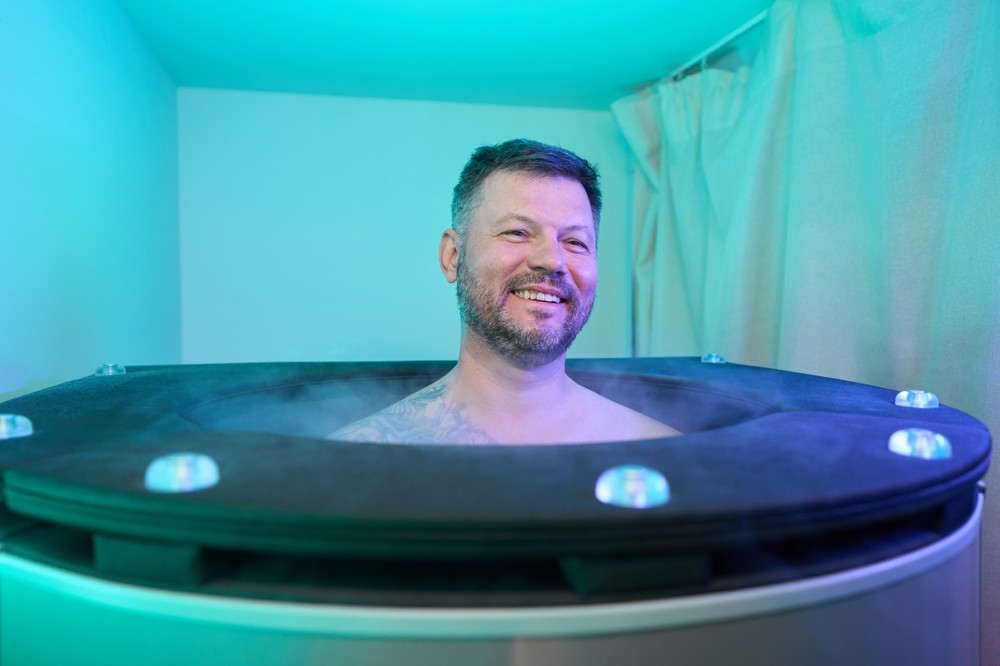Cryotherapy might look futuristic, but it has roots in ancient healing techniques. From elite athletes to skincare clinics, the icy trend has grown into a respected and increasingly mainstream therapy.

What Is Cryotherapy?
Cryotherapy, derived from the Greek word “cryo” (meaning cold), refers to the use of extreme cold in medical treatment. It can be applied to localized areas—such as warts, tumors, or injured joints—or used in whole-body chambers for recovery and wellness. According to the Cleveland Clinic, cryotherapy is now utilized for both medical procedures and wellness applications, making it a highly versatile treatment.
Types of Cryotherapy
There are different methods used depending on the purpose:
- Whole-body cryotherapy: Standing in a chamber cooled to -200°F for a few minutes to stimulate systemic benefits.
- Localized cryotherapy: Applying cold air or liquid nitrogen to a targeted area to reduce inflammation or treat skin lesions.
- Cryosurgery: Medical treatment for skin conditions and internal tumors using cold temperatures to destroy abnormal tissue.
Each of these applications has its own protocols and is suited for different patient needs.
Benefits of Cryotherapy
While some claims are still being studied, the most established benefits of cryotherapy include:
- Pain relief and muscle recovery: Particularly popular with athletes for reducing post-exercise soreness. Mass General Brigham notes that athletes use cryotherapy to shorten recovery time and reduce inflammation.
- Improved circulation: Exposure to cold temperatures can boost circulation and oxygen flow once the body rewarms.
- Skin improvements: Temporary tightening and reduction in puffiness have been reported with facial cryotherapy.
- Reduction of chronic inflammation: Used in some cases for managing symptoms of arthritis and other autoimmune disorders.
- Mental health benefits: Anecdotal evidence suggests improved mood and reduced symptoms of anxiety or depression following cryotherapy sessions.
For a detailed overview of these benefits and their supporting evidence, see this resource from Medical News Today.
Common Uses in Dermatology
In dermatology, cryotherapy is primarily used to treat:
- Warts
- Actinic keratoses
- Skin tags
- Early-stage skin cancers
These conditions are usually treated with cryosurgery, where liquid nitrogen is applied to freeze off abnormal tissue. According to StatPearls via the NCBI Bookshelf, cryotherapy is considered an effective and minimally invasive method in dermatology.
What to Expect During a Cryotherapy Session
Understanding what happens during treatment can help reduce any apprehension:
- Preparation: Clients are typically asked to wear minimal clothing, along with protective gloves and socks to avoid frostbite.
- Session duration: Most whole-body sessions last 2 to 4 minutes, while localized treatments can vary.
- Post-session: You may feel a tingling sensation as your body rewarms, along with an energy boost.
More on the typical procedure and what clients can expect is covered by Physiopedia.
Risks and Considerations
Although generally safe when performed by trained professionals, cryotherapy does come with some risks. These include:
- Skin burns or frostbite if overexposed or improperly conducted
- Temporary redness or irritation
- Dizziness or nausea during whole-body sessions
- Not recommended for people with certain medical conditions like unmanaged hypertension, cold allergies, or cardiovascular issues
According to DermNet, proper screening and aftercare instructions are essential for minimizing side effects and maximizing results.
Who Is Cryotherapy Best For?
Cryotherapy isn’t a one-size-fits-all solution, but it’s particularly well-suited for:
- Athletes: To reduce inflammation and muscle soreness
- People with chronic pain: Such as those with fibromyalgia or arthritis
- Dermatology patients: Treating benign or pre-cancerous skin lesions
- Individuals seeking cosmetic benefits: Temporary skin firming or improved tone
Your healthcare provider or certified technician should help determine if it’s a good fit based on your specific health profile.
How Much Does Cryotherapy Cost?
Prices can vary widely based on location, provider, and treatment type:
- Whole-body cryotherapy: $40–$100 per session
- Localized cryotherapy: $30–$60 per session
- Medical cryosurgery: Typically covered by insurance when used for conditions like warts or precancerous lesions
Packages are often offered at a discount for those doing multiple sessions. It’s worth noting that many providers also offer memberships that reduce the per-session cost over time.
Is Cryotherapy Available in your city?
Cryotherapy has grown in popularity across the U.S., and many wellness centers and sports clinics now offer it in major metro areas and suburbs alike. If you're searching for cryotherapy in your city, check local wellness centers, athletic recovery studios, or dermatology clinics that provide this service. It's essential to ensure the provider is certified and follows proper safety protocols.
Final Thoughts
Cryotherapy’s blend of science and holistic healing continues to attract everyone from top athletes to wellness beginners. Whether you're looking to speed up recovery, improve your skin, or explore alternative treatments for chronic pain, this cold therapy offers a compelling mix of benefits. As always, consult with a healthcare provider before starting any new treatment—especially one as intense as this.
To learn more about procedures, risks, and ongoing research, explore this detailed guide from the Cleveland Clinic or review Medical News Today’s overview on cryotherapy safety and efficacy.
